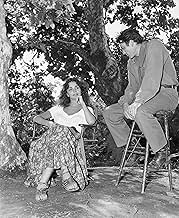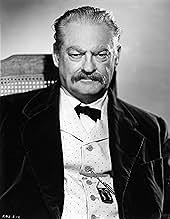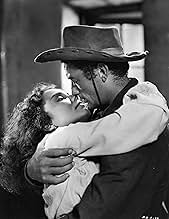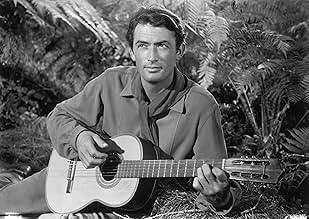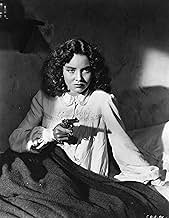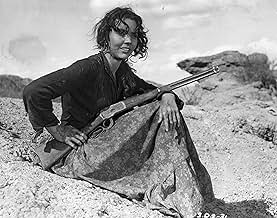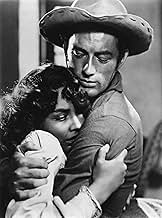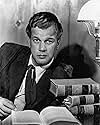IMDb-BEWERTUNG
6,7/10
10.096
IHRE BEWERTUNG
Die schöne, gemischtrassige Pearl Chavez wird zum Mündel der ersten Liebe ihres verstorbenen Vaters und ist hin- und hergerissen zwischen zwei Brüdern, von denen der eine gut und der andere ... Alles lesenDie schöne, gemischtrassige Pearl Chavez wird zum Mündel der ersten Liebe ihres verstorbenen Vaters und ist hin- und hergerissen zwischen zwei Brüdern, von denen der eine gut und der andere böse ist.Die schöne, gemischtrassige Pearl Chavez wird zum Mündel der ersten Liebe ihres verstorbenen Vaters und ist hin- und hergerissen zwischen zwei Brüdern, von denen der eine gut und der andere böse ist.
- Für 2 Oscars nominiert
- 3 Gewinne & 4 Nominierungen insgesamt
Griff Barnett
- The Bordertown Jailer
- (Nicht genannt)
John Barton
- Party Guest
- (Nicht genannt)
Empfohlene Bewertungen
This movie is like a painting by an old master that hangs in a museum--we may not be moved by it, but we can still appreciate the artistry. Its most notable feature is the director, King Vidor, master of silent film making. As you might expect, many of the important scenes have little or no dialog. In one scene between Lionel Barrymore and Lillian Gish, he rambles on about their life together, while she strains to get out of her sickbed and crosses slowly to him, the entire distance transfigured by the depth of her love for him. Gish was a great star of silent film, with a wonderful, expressive face, full of compassion and grace. In another scene that happens under quite different circumstances, Jennifer Jones crawls to Gregory Peck, the man she loves, also without words, evincing great sorrow and quiet dignity. In both cases, the women prove they are far more noble than the men who love them so badly. Jones also has a mobile face, together with a beautiful, resonant voice. No film that has these two ladies at its center should be missed. In addition, the film has two marvelous scenes that, at the time of its making, would have been just as impressive as some of today's special effects wonders: In the first, about 20 armed horsemen face a crowd of railway workers, including some chinese, clothed in authentic period dress, with a steam engine in the background. As the tensions mount, a troop of mounted cavalry, about 100 strong, ride onto the set, filmed on location (judging by the saguarros and ocatillos) in Arizona. This was a tour de force of filmmaking at a time when shooting on location was rare. In the second scene, a train under a full head of steam jumps the tracks and plows down an embankment. Filmed in early technicolor, this movie has lush exteriors and panoramas of rich desert color. Two more character actors should be mentioned, both of whom steal every scene they enter: Butterfly McQueen, the maid whose comments are both simple and profound, and Walter Huston, as the crusty sheriff who doubles as a preacher during a funeral.
Well, it's obvious that Selznick was trying his best to recapture that GWTW magic...but this is an unbelievably inept failure. Here's what you can expect from this overblown sex-western:
--Jennifer Jones (in pancake make-up so orange that she put me more in mind of an Oompa-Loompa than the half-breed we're supposed to see) apparently directed to act as though she's Scarlett O'Hara with a lobotomy and bad grammar.
--Gregory Peck as rogue murdering rapist and the apple of his daddy's eye. At one point even doing a pretty decent vocal imitation of Clark Gable -- too bad it's just the voice.
--Lionel Barrymore lazily repeating his "It's a Wonderful Life" role from the same year -- wheelchair & grumpiness standing in for effort.
--Butterfly McQueen as kerchiefed ditzy maid. Hmmm, wonder where they got that idea?
All in all, a miserable movie experience. You'd think that since they cribbed from the best it'd have turned out better! Go figure.
--Jennifer Jones (in pancake make-up so orange that she put me more in mind of an Oompa-Loompa than the half-breed we're supposed to see) apparently directed to act as though she's Scarlett O'Hara with a lobotomy and bad grammar.
--Gregory Peck as rogue murdering rapist and the apple of his daddy's eye. At one point even doing a pretty decent vocal imitation of Clark Gable -- too bad it's just the voice.
--Lionel Barrymore lazily repeating his "It's a Wonderful Life" role from the same year -- wheelchair & grumpiness standing in for effort.
--Butterfly McQueen as kerchiefed ditzy maid. Hmmm, wonder where they got that idea?
All in all, a miserable movie experience. You'd think that since they cribbed from the best it'd have turned out better! Go figure.
Everything about 'Duel in the Sun' is overripe: the music, the photography (those red sunsets a la GWTW), the strong emotions and the climactic duel on a blazing desert sun by the two mismatched lovers. Indeed, the excesses are almost operatic in proportion--and yet, a viewer can get caught up in this sprawling western rightly termed "Lust in the Dust" by some reviewers. The rampant sensuality of the steamy scenes between Peck and Jones are emphasized by Dimitri Tiomkin's luscious background score which becomes blistering and intense for the climactic shootout. Overproduced, overacted, overwritten--it still entertains and makes us appreciate the genius of David O. Selznick whose hand on all of the material is quite evident. Jennifer Jones was nominated for her tempestuous Pearl Chavez (but lost to Olivia de Havilland for 'To Each His Own'). Lillian Gish deserved her Oscar nomination. And last but not least, let's not forget Walter Huston, who gives the most realistic and enjoyable performance in the entire film as The Sin Killer--a wickedly funny portrayal. Weakest aspect of the film is Gregory Peck's easygoing villain--his whole performance strikes a false note and is not the least bit convincing. He and Joseph Cotten should have switched their roles--Cotten always made a more believable villain than Peck. Selznick obviously was striving to make a western on the level of GWTW--even including Butterfly McQueen for comic relief. All in all, fun to watch if you don't take any of it seriously. Not exactly a work of art--but definitely worth watching. And, oh, that ripe technicolor!
No need to recap the plot.
One thing about this overblown fandango— once seeing it, you won't forget it. How could anyone when everything is done to such tasteless excess. Poor Pearl (Jones). Apparently, Jones was told her part was that of a hot-blooded wench, which she unfortunately took to mean parboiled. It's hard not to laugh at the first hour when she acts like a nympho on steroids, tossing hair and leering wildly like pampas grass in a windstorm. Not far behind is that vintage ham Lionel Barrymore doing his usual blustery bit, like we won't get his hard-bitten patriarch unless he takes it into hyper speed. And who could have guessed that the usually constricted and constrained Gregory Peck could actually over-act. I think it was his first and last time—good thing, too.
It's possible to go on about the unrelenting excess— the sunsets that appear to hemorrhage, a musical score that's as necessary as sugar on molasses, and a loony ending that defies parody. But you get the idea. Too bad so much money and effort went into such a generally overheated result. Only Cotten, Gish and the black stallion come through unscathed. I'm thinking RKO could have made a dozen worthwhile programmers on the same budget. As things turned out, Selznick did his beloved Jones no favors with this one. It's hard to believe the man responsible for Gone with the Wind (1939) is also responsible for this swollen mess.
One thing about this overblown fandango— once seeing it, you won't forget it. How could anyone when everything is done to such tasteless excess. Poor Pearl (Jones). Apparently, Jones was told her part was that of a hot-blooded wench, which she unfortunately took to mean parboiled. It's hard not to laugh at the first hour when she acts like a nympho on steroids, tossing hair and leering wildly like pampas grass in a windstorm. Not far behind is that vintage ham Lionel Barrymore doing his usual blustery bit, like we won't get his hard-bitten patriarch unless he takes it into hyper speed. And who could have guessed that the usually constricted and constrained Gregory Peck could actually over-act. I think it was his first and last time—good thing, too.
It's possible to go on about the unrelenting excess— the sunsets that appear to hemorrhage, a musical score that's as necessary as sugar on molasses, and a loony ending that defies parody. But you get the idea. Too bad so much money and effort went into such a generally overheated result. Only Cotten, Gish and the black stallion come through unscathed. I'm thinking RKO could have made a dozen worthwhile programmers on the same budget. As things turned out, Selznick did his beloved Jones no favors with this one. It's hard to believe the man responsible for Gone with the Wind (1939) is also responsible for this swollen mess.
Well, it's no Gone With The Wind. Selznick, again, features his wife, Jennifer Jones, in a different role than the usual wholesome roles she was expected to do. Portrait Of Jennie, Since You Went Away and Song of Bernadette. Jones has a bad habit of over-acting if allowed to do so. Example is Tender Is The Night, Man In A Grey Flannel Suit, Ruby Gentry and Love Letters. It takes a strong director to tone her down. King Vidor lost control of her in this or Selznick had too much control. Her performance consisted of a low gutteral voice and a sashaying walk. Not much else.
On the other hand, excellent supporting roles were played by Lionel Barrymore and Lilian Gish. They stole the picture in this viewer's opinion. Gregory Peck and Joseph Cotton went through the paces of what they were asked to do as rivalry brothers. But you kind of knew their hearts weren't in it. Then there was the presence of Butterfly McQueen in her usual Gone With The Wind type performance. Charles Bickford in an undistinguished role was wasted as was Herbert Marshall and Sidney Blackner [all good actors]. An impressive cast when the titles came on, but what followed was not what you wanted to see.
I got tired of seeing Jennifer Jones strutting about making faces of some indian half-breed. Boring. Oh, I liked the horse [the pinto] that she rode. He was terrific. Best to see this on video. Doesn't come off that bad. But it is a cornball western farce.
On the other hand, excellent supporting roles were played by Lionel Barrymore and Lilian Gish. They stole the picture in this viewer's opinion. Gregory Peck and Joseph Cotton went through the paces of what they were asked to do as rivalry brothers. But you kind of knew their hearts weren't in it. Then there was the presence of Butterfly McQueen in her usual Gone With The Wind type performance. Charles Bickford in an undistinguished role was wasted as was Herbert Marshall and Sidney Blackner [all good actors]. An impressive cast when the titles came on, but what followed was not what you wanted to see.
I got tired of seeing Jennifer Jones strutting about making faces of some indian half-breed. Boring. Oh, I liked the horse [the pinto] that she rode. He was terrific. Best to see this on video. Doesn't come off that bad. But it is a cornball western farce.
Wusstest du schon
- WissenswertesAccording to King Vidor, director Josef von Sternberg was hired only as a lighting expert by David O. Selznick in order to give his wife--and the film's star--Jennifer Jones a more glamorous look.
- PatzerThe opening shows saguaro cacti in the valley. The film is supposed to take place in Texas, but southern Arizona is the only place in the US with saguaro cacti, unless they've been transplanted.
- Zitate
The Sinkiller: Under that heathen blanket, there's a full-blossomed woman built by the devil to drive men crazy.
- Alternative VersionenThe original "roadshow" version ran 144 minutes. The additional 16 minutes, over the commonly-shown 128 minute version, consisted of a musical "prelude," an "overture" (which contained a spoken prologue, by Orson Welles), and exit music, but no additional scenes in the film. The two additional opening sequences were each inadvertently given the other's label.
- VerbindungenEdited into Geschichte(n) des Kinos: Une histoire seule (1989)
Top-Auswahl
Melde dich zum Bewerten an und greife auf die Watchlist für personalisierte Empfehlungen zu.
- How long is Duel in the Sun?Powered by Alexa
- What is 'Duel in the Sun' about?
- Is "Duel in the Sun" based on a book?
- Where does this movie take place?
Details
- Erscheinungsdatum
- Herkunftsland
- Sprache
- Auch bekannt als
- Duelo al sol
- Drehorte
- Tucson Mountain Park, Tucson, Arizona, USA(final duel)
- Produktionsfirmen
- Weitere beteiligte Unternehmen bei IMDbPro anzeigen
Box Office
- Budget
- 8.000.000 $ (geschätzt)
- Bruttoertrag in den USA und Kanada
- 20.408.163 $
- Weltweiter Bruttoertrag
- 20.428.771 $
- Laufzeit2 Stunden 18 Minuten
- Seitenverhältnis
- 1.37 : 1
Zu dieser Seite beitragen
Bearbeitung vorschlagen oder fehlenden Inhalt hinzufügen

Oberste Lücke
By what name was Duell in der Sonne (1946) officially released in India in English?
Antwort

